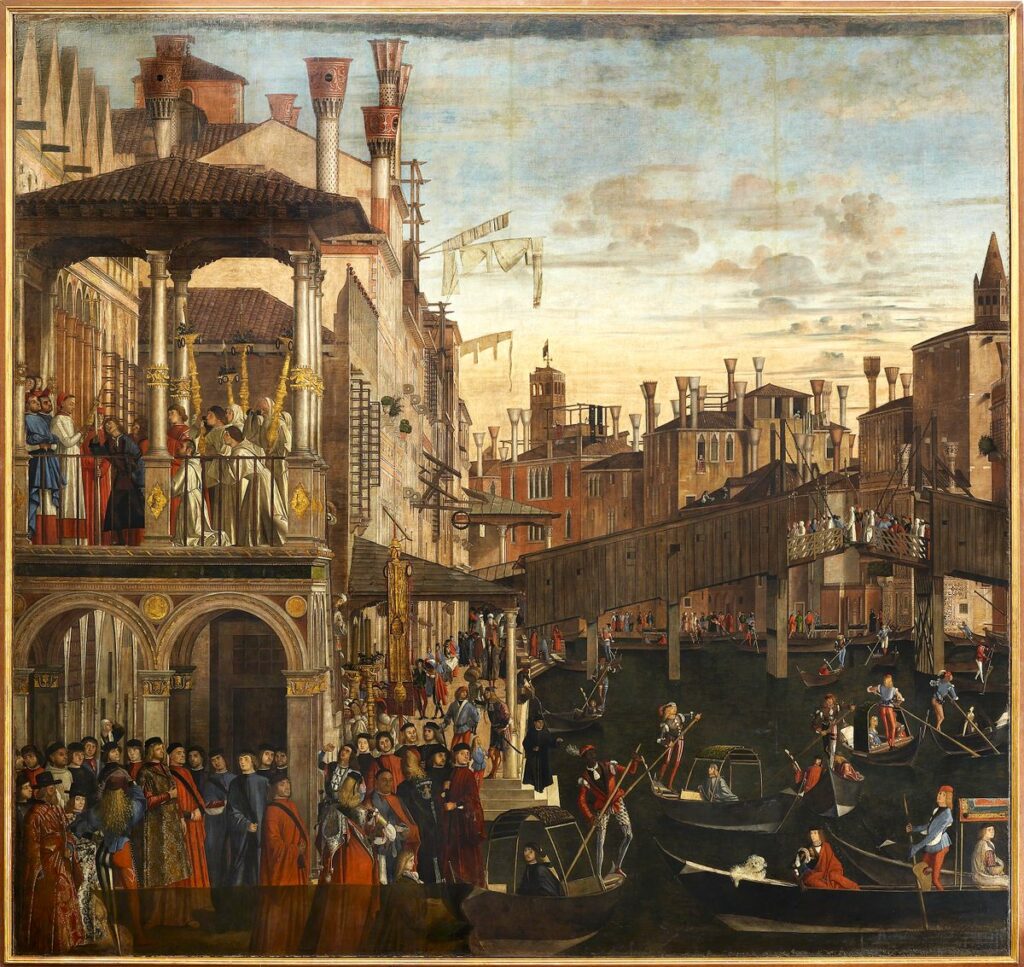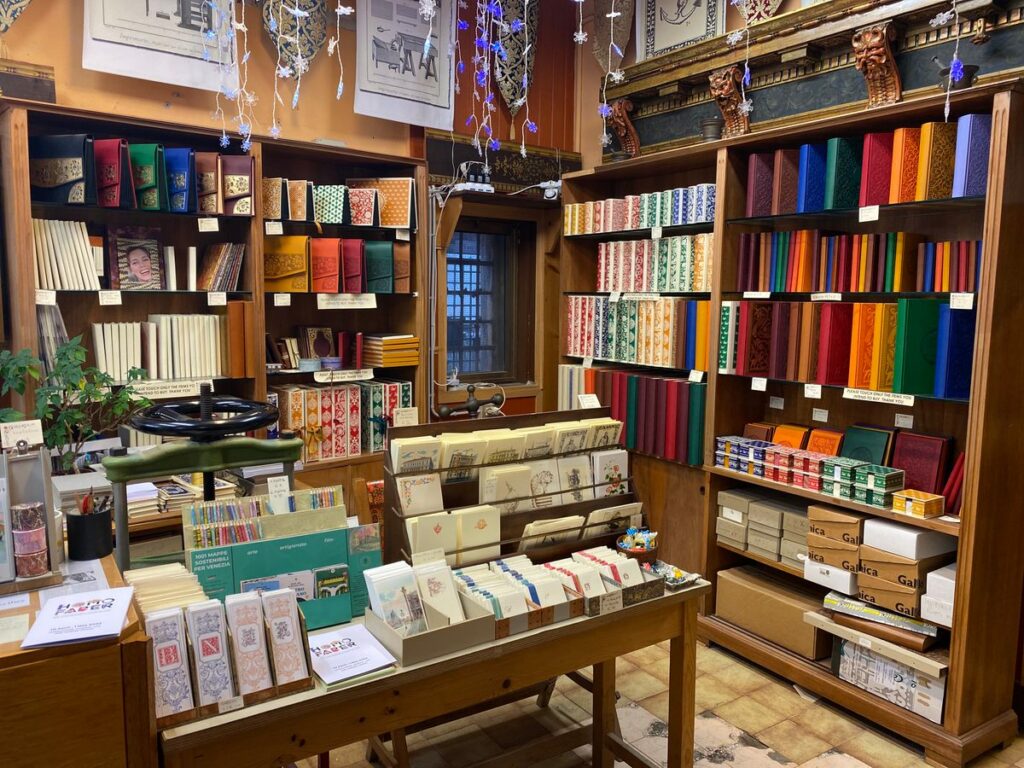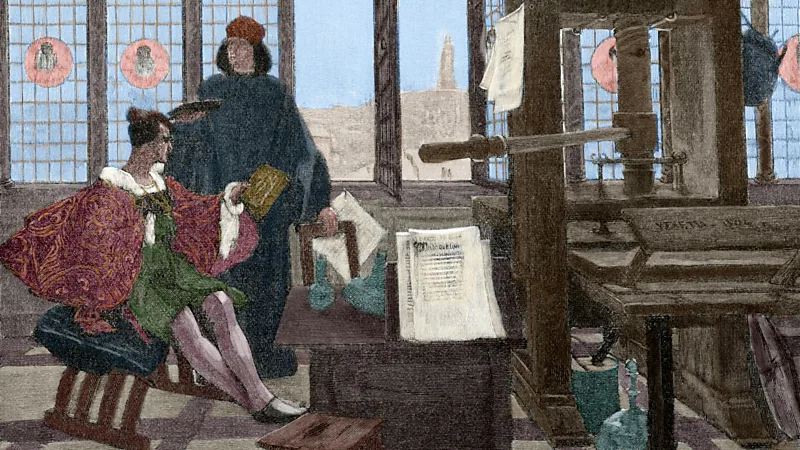Although Germany is commonly associated with the birthplace of printing due to Johannes Gutenberg’s invention of the movable-type printing press in the mid-15th century, it was the Venetian Republic that significantly advanced the development of the publishing industry.
A Fertile Ground for Knowledge Exchange
It was in Venice that Gutenberg’s invention really took off. “Venice became the most important city for the printing industry in the first century since the printing press was invented,” says Rosa Salzberg, an Early Modern historian at the University of Trento. “Prospective bookmakers could find both the capital and the skills needed to make books here.”

Fifteenth-century Venice, as depicted in Miracle of the Relic of the True Cross at the Rialto Bridge or The Healing of the Possessed Man, by Vittore Carpaccio, 1494. MONDADORI PORTFOLIO/GETTY IMAGES
During the 15th century, printing defined much of Venice’s street life. As explained by Alessandro Marzo Magno in Bound in Venice: The Serene Republic and the Dawn of the Book, the city’s tiny calles (streets) were filled with the workshops of various craftsmen involved in the book industry.
People interested in creating books went there to buy loose sets of printed pages, and then took them to binders, illustrators, and goldsmiths to create a volume. There were no set prices. Bargaining was the order of the day in what Marzo Magno describes as a “Middle Eastern souk.” By the 16th century, half of Europe’s print shops could be found in La Serenissima (the Most Serene Republic, that is, Venice).
The Republic of Venice was one of the wealthiest and most influential cities in Europe at the time. Its strategic location at the heart of the Mediterranean trade network and its openness to new ideas created the perfect conditions for the publishing industry to thrive.
But the city’s dominance in trade wasn’t the only reason publishing thrived in Venice. “The Venetian artisan and commercial world was extremely dynamic and open to novelties,” Benedetti said.
One of the richest cities in Europe at the time, the Serenissima – as the Venetian Republic was known – was a cosmopolitan city, a place so powerful and important that even Rome and the Catholic Church often failed to subjugate and censor it. Venice offered a fertile ground for the leap in culture started by Gutenberg’s invention.
One of the other factors that contributed to Venice’s publishing success was its cosmopolitan nature. Unlike many other cities, Venice was free of censorship (at least until 1553), which allowed for virtually any manuscript to be published. The city attracted immigrants from many countries, leading to books being printed in a variety of languages, including Greek, Glagolitic, German, Hebrew, Arabic, and Armenian.
The Aldine Press and the Rise of Affordable Books
One of the defining innovators of Venetian printing industry was an immigrant himself. Aldus Manutius was born in 1452 in the Vatican. A classically educated man, he worked for some years as a private tutor for noble families in central Italy. But when he heard about the printing press, he left that career to start a venture in the Republic of Venice. Founded in 1494, the Aldine Press became one of the most innovative printing businesses of its time.

Italics took less space on the page than Gothic characters, allowing Manutius to print books that were smaller and more affordable (Credit: History and Art Collection/Alamy)
Manutius introduced several innovations that revolutionized the industry, such as the use of italic type, the octavo format (a smaller, more portable size), and the first recorded copyright granted by the Venetian government.
Manutius’ innovations made books more affordable and accessible to a wider audience. Previously, only the aristocracy and clergy had access to books, but now, many in the middle class could afford to own them.
The Printing Industry in Venice
By the end of the 15th century, Venice had become the primary center of European publishing. Close to 250 publishers – both large and small – operated in the city during the 16th Century, resulting in the printing of at least 25,000 editions of books and making Venice the de-facto centre of European publishing.
The printing industry in Venice was highly competitive, with many prestigious publishing families, such as the Sessa, Giunta, Scoto, and Giolito, establishing themselves in the city.
The Decline of Venetian Publishing
Despite its initial success, Venetian publishing began to decline in the late 16th century. The rise of the Inquisition and the Catholic Church’s increasing control over the printing industry led to censorship and restrictions on the freedom of the press.
Moreover, the Republic of Venice itself began to lose its political and economic power, as it faced challenges from other European powers and internal conflicts. By the 18th century, Venice had lost its status as the primary center of European publishing, and the industry shifted to other cities, such as Paris and London.
Keeping old Venetian bookbinding alive
At 81, Olbi is one of Venice’s most famous bookbinders and the only one with his own printing press. For more than 50 years he’s been working with paper, making hand-bound notebooks, leather-embossed photo albums and hand-printed diaries. He’s owned several shops, one of which still exists, and trained almost 100 bookbinders to keep the city’s bookmaking traditions alive.

Olbi’s shop is located next to Ca’ Foscari bridge in the Dorsoduro area of Venice.
“I started learning handmade bookmaking at 18,” he says. “And 60 years later I am still loving it.” The books for sale at Olbi’s store are traditionally hand-bound, using techniques that can only be learned through apprenticeships with masters of the form. When he started in this trade, there were around 20 traditional bookbinding shops in Venice. Today, he is one of just three.
The Republic of Venice played a crucial role in the development of the publishing industry, thanks to its strategic location, openness to new ideas, and freedom of press. The innovations introduced by the Aldine Press and the contributions of many printers and publishers made Venice the primary center of European publishing in the 15th and 16th centuries.
At Machine Dalal, you will find a wide selection of printing, packaging and converting equipment including foil packaging machines from sellers worldwide. We as an online platform are committed to tapping new business opportunities for both sellers and buyers of printing equipment across the globe.
With our aim for high levels of customer satisfaction, we will do everything that we can to accommodate you and meet your expectations.
Contact us to know more and download the app for a richer, more personalized experience or contact us to know more.
Subscribe to our newsletter for the latest news and updates on recently listed Print, Packaging and Converting equipment.




